Of all the rattlesnakes in the world, sidewinders are one of the most famous. As you might have guessed from their name, they move using a peculiar “sidewinding” motion. Here, we’ll discover the largest sidewinder rattlesnake ever recorded and much more.
Sidewinders are similar in appearance to most other kinds of rattlesnakes, like the prairie rattlesnake and eastern diamondback rattlesnake. They’re non-aggressive and rarely bite people.
Like most snakes, sidewinder rattlesnakes eat small creatures, which they hunt with their heat vision. They’re pit vipers and live exclusively in the southwestern US and Mexico. Though they present little danger to humans, sidewinders are often killed out of fear and misapprehension.
That’s why, now more than ever, it’s important to understand these incredible creatures.
Watch the Video on YouTube
Read on to learn more about the largest sidewinder rattlesnake ever recorded!
The Biggest Sidewinder Rattlesnake on Record
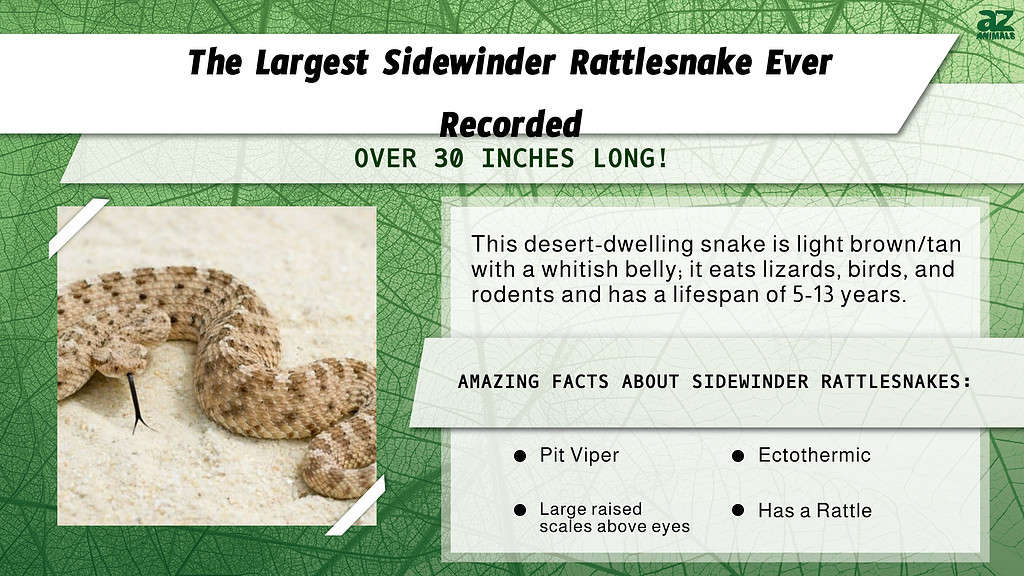
Although there are four species of viper, all commonly known as sidewinders, only one is the sidewinder rattlesnake (Crotalus cerastes). They’re also known as horn vipers or horned vipers. Most sidewinders grow to 20 inches long (just under two feet). The largest sidewinder rattlesnake ever recorded measured at over 30 inches long, or 2.5 feet. The upper bound for sidewinder rattlesnakes according to The Venomous Reptiles of the Western Hemisphere is 31.5 inches, with females being larger than males.
Species Profile: Sidewinder Rattlesnake
Sidewinder rattlesnakes are pit vipers. They’re native to the southwestern United States and northern Mexico. They don’t grow quite as large as other rattlesnakes, but they’re comparable in size to the pygmy rattlesnake, which is common in the southeastern United States.
Let’s take a closer look at all the things that make this snake unique!
Are Snakes Venomous or Poisonous: What’s the Difference?
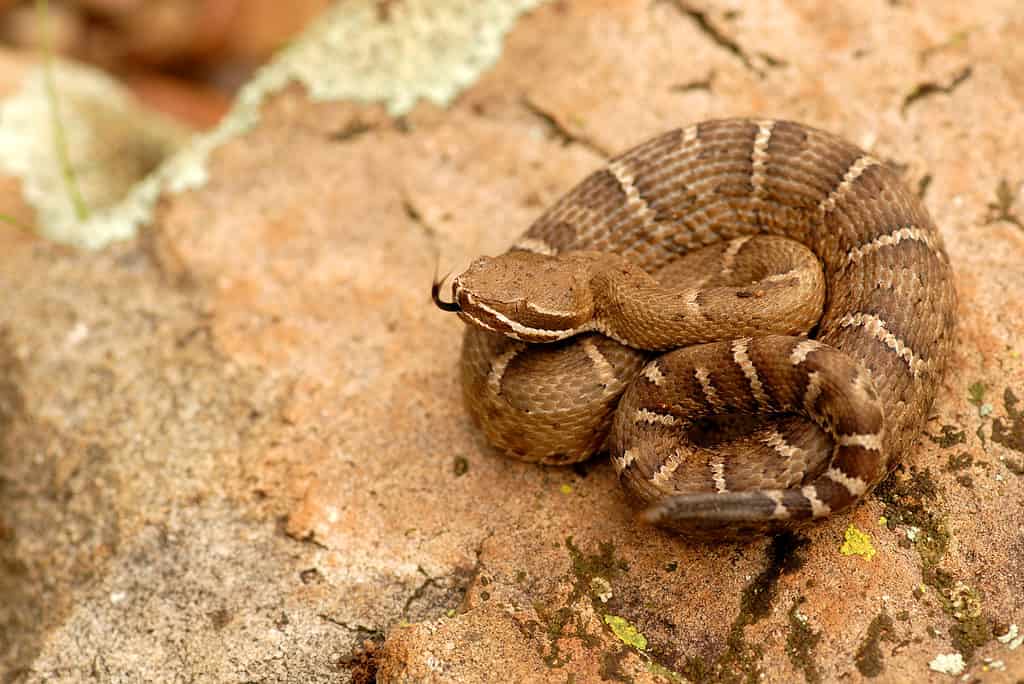
Snake venom is a complex mixture of proteins and enzymes that can vary widely between different snake species and even among individuals within the same species.
©Rusty Dodson/Shutterstock.com
Snakes are fascinating creatures that have evolved to survive in a wide range of environments. One aspect of snake biology that often causes confusion is the difference between venomous and poisonous snakes. While these terms are often used interchangeably, they actually have distinct meanings that are important to understand.
The key difference between venomous and poisonous snakes is in the way they deliver their toxins. Venomous snakes inject their toxins into their prey or a potential predator through fangs, while poisonous snakes deliver their toxins through the skin or other mucous membranes.
Venomous snakes, such as rattlesnakes and cobras, have specialized glands that produce venom. This venom is then injected into their prey or a potential predator through their fangs. Venom can cause a range of effects on the body, from pain and swelling to paralysis and death.
However, not all venomous snakes are dangerous to humans, and some species of venomous snakes are not harmful at all.
In contrast, poisonous snakes, such as the golden poison frog or the blue-ringed octopus, secrete their toxins through their skin or other mucous membranes.
Appearance
The most recognizable aspects of the sidewinder rattlesnake’s appearance are its rattle and the horns above its eyes. Sidewinders don’t have true horns. Instead, they’re large, raised scales, which may help shade their eyes from the sun. Even the largest sidewinder rattlesnake ever recorded had a rattle, though rattle length cannot be used to determine the age. As rattlesnakes grow, the tip of the rattle frequently breaks off, making room for new rattle sections.
Sidewinders are generally very light in color, with darker splotches of color along their backs and sides. Their bellies are pale cream in color, while their sides and back are tan and light brown. Further, they have yellow eyes with narrow, vertically split pupils.
Behavior
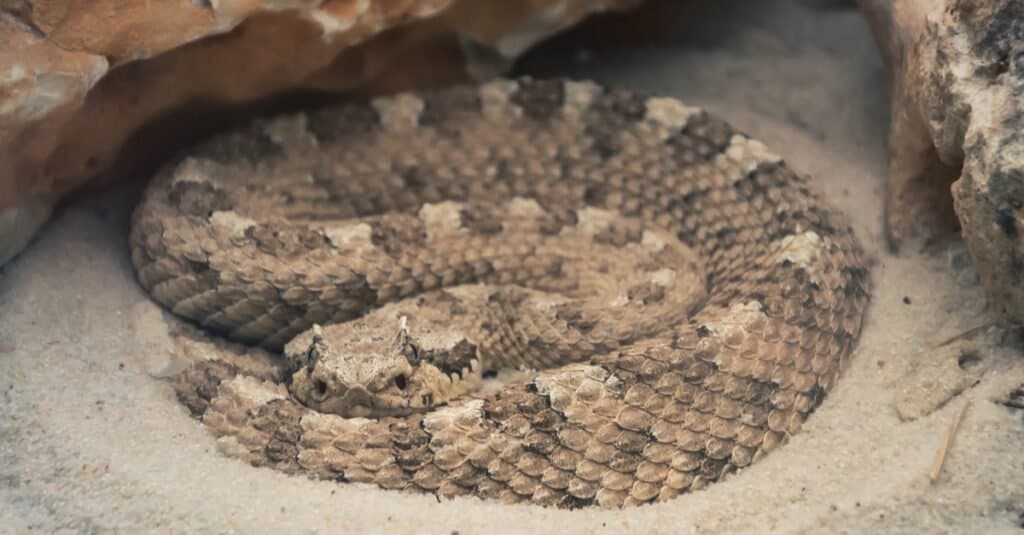
The sidewinder rattlesnake is ectothermic, which means it cannot control its own body temperature.
©RA fotografia/Shutterstock.com
The sidewinders are some of nature’s most proficient hunters. Using their heat and scent-sensing abilities, they follow prey to their burrows. Then, they wait, coiled up into an ‘S’ position. Once the prey comes close enough, the sidewinder strikes in a move so fast that few creatures can evade it.
But, perhaps even more impressive than its hunting strategy is the sidewinder rattlesnake’s method of locomotion. Normally, snakes slither forward, with most of their body touching the ground. But, because of the extreme heat of the desert sands, sidewinder rattlesnakes have evolved to move while most of their body remains elevated. To do this, they shift their bodies sideways, one-half at a time. This results in the curious “sidewinding” motion and keeps them cool at the same time.
During cooler months, sidewinders usually limit their activity to daytime hours. Alternately, depending on the climate, they may go into full brumation until the mating season starts back up in spring. Then when the weather is warmer, these snakes become nocturnal.
Habitat
Sidewinder rattlesnakes are endemic to the desert lands of southwestern North America and northern Central America. Specifically, they live in California, Arizona, Utah, New Mexico, Baja, and northwestern Mexico. Because they live in such mercilessly hot settings, sidewinders hunt mostly at night. During the day, they stay cool and conserve energy by sleeping in the shade of rocks or abandoned rodent burrows.
Diet
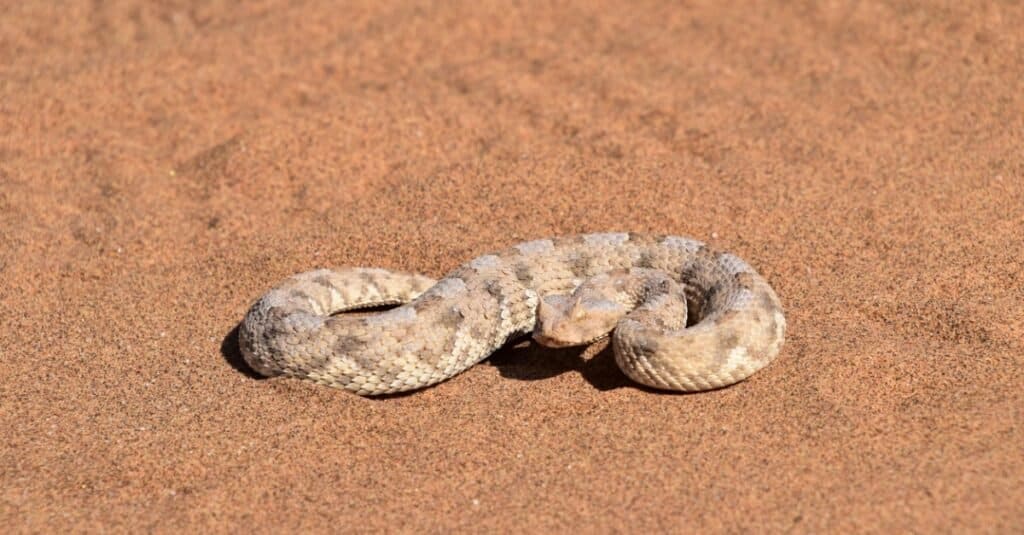
Sidewinder rattlesnakes eat mostly reptiles when young, shifting to mostly mammals as adults.
©iStock.com/Josh Mitchell
As juveniles, sidewinder rattlesnakes are only big enough to eat small prey, like lizards. In fact, their diets consist almost entirely of small reptiles until they get big enough to take down the larger (relatively) creatures of the desert. Adult sidewinder rattlesnakes eat lizards, birds, and rodents. The biggest component of their diet is mammalian, with mice and rats high on the list.
Reproduction
Sidewinder rattlesnakes give birth to an average of 10 snakes per litter that are born in an embryonic membrane. Upon birth, the young snakes are known as snakelets. For the first week, the baby sidewinders stick together to conserve heat during cold desert nights. Their mother provides protection for newborns during this period. However, once they shed their skin, they’ll venture out on their own.
Lifespan
Sidewinder rattlesnakes are remarkable creatures with a unique life cycle. Females typically have a short lifespan of just 5 years, while males can make it up to 13 years in the wild. This is significantly shorter than other species of rattlesnakes, which can live up to 20 years or more.
In captivity, sidewinders can live much longer due to better food and care. Some have even been known to reach over 20 years old. This suggests that the primary cause of mortality among female sidewinders is a lack of energy reserves since they often die shortly after giving birth in the wild, whereas predation is more likely to be a major factor for male mortality rates. Other factors, such as disease or vehicular collisions, also contribute significantly towards reducing their population size in natural habitats.
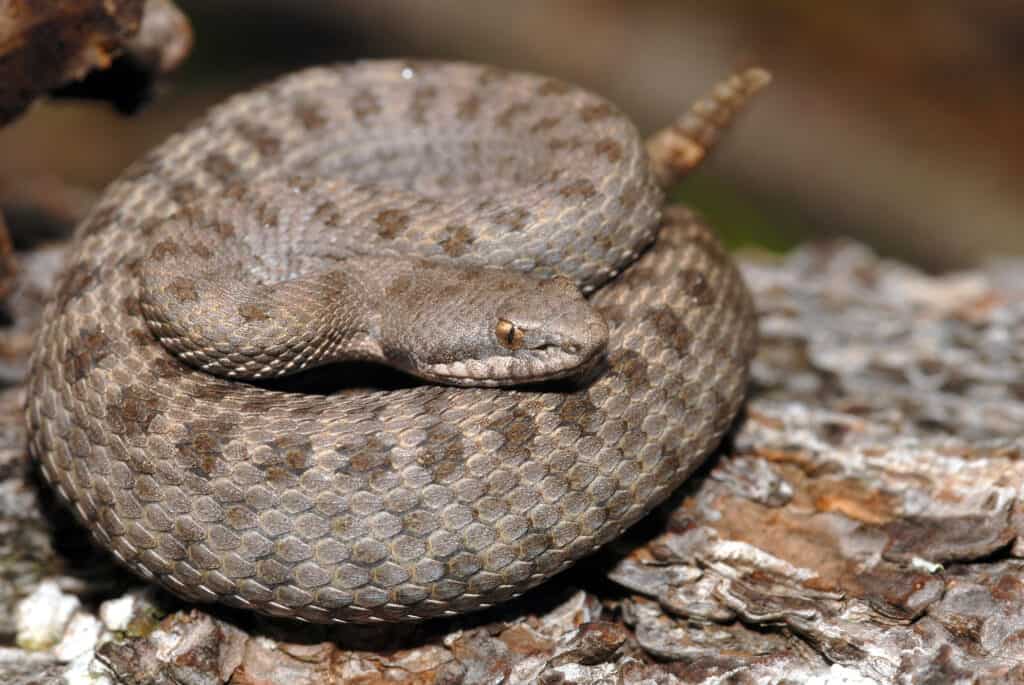
Twin-spotted rattlesnakes are venomous from the day they are born
©Rusty Dodson/Shutterstock.com
Despite their short lives, sidewinders are an incredible species that continue to fascinate us with their behavior and longevity. With the right protection and care, these beautiful snakes can live long, healthy lives and be enjoyed by many for generations to come.
Venom
As pit vipers, sidewinders have heat-sensing pits and large venom glands. Their heat-sensing pits are located near their nostrils, while their venom glands sit just behind their eyes. The venom courses through hollow, switchblade-like fangs and into their prey. Once bitten, rodents generally succumb within minutes or hours, depending on the amount of venom injected.
In cases of human bites, not all attacks actually inject venom. Many self-defense bites are ‘dry,’ though all rattlesnake bites should be treated by medical professionals.
Conservation
Sidewinder rattlesnakes are currently listed as Least Concern. As long as their habitats remain unfragmented and their prey remains readily available, they should survive as a species for a very long time.
If you happen upon a sidewinder in the wild, remember: look, but don’t approach. Never attempt to touch or harass a sidewinder rattlesnake. They only bite if threatened and do not hunt or seek out humans. Like most wild animals, they would rather be left alone.
Rattlesnake Vs Alligator: Who Would Win the Fight?
Rattlesnakes and alligators are both extremely dangerous predators. Alligators are notorious for their large jaws and rattlesnakes are known for their rattles and their venom.
Both of these catch their victims by surprise and will often stay hidden out of sight before striking.
Although both are dangerous, however, the alligator would be the clear winner due to its sheer size.
Is It Normal For Sidewinders to Be This Big?
The sidewinder rattlesnake is a small species. Adults usually measure between 19.5 and 22 inches long. The upper range of their size is 31.5 inches long, with female sidewinders growing larger than males.
Other Record-Breaking Snakes
According to the Guide to the Amphibians and Reptiles in California, snakes belonging to the subspecies D. p. regalis tend to grow longer than 18 inches (45.7 cm).
The largest regal ringneck snake ever recorded measured an impressive 33.6 inches (85.4 cm), which is considerably longer than most other subspecies that usually grow up to 15 inches (38 cm) in length. Unfortunately, there is no official information on the location or circumstances of the discovery of this snake.
In a study conducted on northern ringneck snakes in Virginia, the state record for the longest snake is 19.5 inches (49.52 cm), whereas the world record is 27.8 inches (70.6 cm).
The photo featured at the top of this post is © iStock.com/Josh Mitchell
Discover the "Monster" Snake 5X Bigger than an Anaconda
Every day A-Z Animals sends out some of the most incredible facts in the world from our free newsletter. Want to discover the 10 most beautiful snakes in the world, a "snake island" where you're never more than 3 feet from danger, or a "monster" snake 5X larger than an anaconda? Then sign up right now and you'll start receiving our daily newsletter absolutely free.
Thank you for reading! Have some feedback for us? Contact the AZ Animals editorial team.






